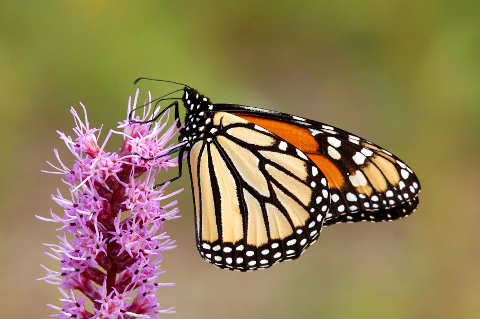
SCIENTIFIC NAME
Danaus plexippus
DESCRIPTION
Adult wingspan is approximately 9–10 cm. Adult (butterfly) wings are orange with black veins. The hind and forewings have a double row of white spots within a thick black border. There are pale orange and white spots near the tip of the forewing (apex). The underside is similar, though the hind wing is a paler orange. Its black body also had white spots. Newly hatched caterpillars (larvae) are pale green with a dark head. Mature caterpillars have black, white and yellow bands. They have a pair of black filaments (thin fleshy parts that resemble antennae) at the head and tail. The longer pair is at the head.
RANGE
Monarch Butterflies are predominantly found from Alberta to Nova Scotia with some also found in portions of southern British Columbia.
HABITAT
Open woodlands, fields and meadows, marshes, roadsides, gardens.
DIET
Adults (butterflies) eat flower nectar from a variety of plants with open or deep flowers. Young (larvae/caterpillars) feed on any of Canada’s 14 native milkweeds, especially common milkweed (Asclepia syriaca). Milkweed toxins (cardiac glycosides) make them distasteful to birds, with the exception of a few species at the overwintering sites in Mexico. This poison is stored and passed on to their adult form.
BEHAVIOUR
undefinedPRIMARY ECOSYSTEM ROLES
- Pollinator (Their pollination services come into play as pollen gets on their legs and when they land and drink, helping the transfer of pollen from flower to flower.)
- 0
- 1
